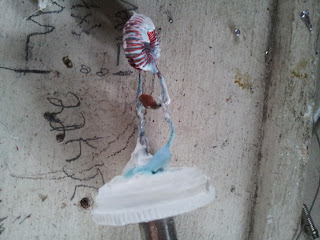This is part 1.
Click for Part 2
and Now we even have a part 3!
I'm participating in this year's "
NJQRP Club Skeeter Hunt" as a skeeter, and I decided to limit myself to one band and one antenna, mainly for simplicities sake. I don't have a multiband QRP rig, and I'm figuring 40 will be dead or noisy while the sprint is active, so 20m it is! Because I'm limited in both power and frequencies, using a dedicated antenna makes sense. I began researching antennas, when twitter gave me an idea.
W0EA
is an awesome ham. So far, I've only worked him once. I hope to change
that though. He regularly builds things, and has given good reviews
about the various kits he has built. Recently, he decided to make a very
small very portable station, choosing for his antenna an end fed wire
with custom tiny matcher. He calls it, the "
Micro-Matcher". The Micro-Matcher is basically a shrunken version of the
Par-End Fedz matchbox.
Parts List:
- 35' 1" of antenna wire, I used wireman #544 , 14 gauge Flexweave, with the Army Green vinyl cover. Good stuff!
- 1 FT50-43 core, the biggest different between my matcher and TJ's. he used a smaller size 37 core. I have some 37's, and I have no idea how he wrapped 27 turns on it.
- length of enamelled magnet wire, 24 gauge. It's what I had in the shack.
- 1 fujifilm film canister. Old school!
- 1 BNC connector
- 2 UMHW pulleys, used for an end insulator, and suspension point for the antenna.
- 1 150pf capacitor. Mine is marked 151J, making it a 50v NP0 ceramic disc cap. I wish I had a higher voltage rated monolithic cap, but I decided to give it a go.
The eldest child came outside to help me build the antenna last Friday when her sisters fell asleep. She's been a good helper in my antenna building efforts.
 |
| Cores and Cap |
I had "fun" looking for the cap. Some time ago, I purchased several ceramic disc assortment from Radio Shack, I sorted some of them, but have a drawer with nothing but disc caps! Fortunately, I'd already sorted out some 150pF caps.
 |
| Notice the size of the core, FT37-43s are even smaller. |
|
Before I wound the iron donut I decided to go ahead and cut the wire and prep it so that the kiddo could stay involved. She helped me cut and prep the half wave section of the antenna, notice from the pic below that I didn't solder the wires, they are merely twisted together. This was strong enough to allow for testing, but temporary, so it was pretty easy to trim to match.
 |
| End Insulator, held by 1st harmonic |
 |
| Iron donut, wrapped! |
|
I wrapped the primary and secondary on the iron donut. The secondary on this one goes on first. It's 27 windings, and the primary is 3 windings. in this picture, the short leads are for the secondary, the long for the primary. When it got to this point Friday night, I had to go in because the skeeters were about to carry me away, and the kiddos were waking up from their nap hungry for supper. I went to bed hungry for QSOs...
 |
| hooked up for preliminary testing. |
Saturday morning, I headed back outside with the kids, and we played around, then I went to the shack, and spent about 30-45 minutes hooking everything up. I had time to deploy once, and check the SWR, before going to work. It was high. I posted my results to Twitter, and made plans to cut some wires when I got home.
 |
| talkin' shop Saturday morning |
|
While all the cool hams went about participating in Field Day, I was at work. Next year, I have GOT to take FD off! I bided my time at the office, and when I got home, I couldn't rest until I got out to my shack and got to work matching the antenna.
 |
| That which I trimmed |
I made it a point to have the antenna preset in the air so that I could easily get it up and down for the matching process. I cut the ends of the wires, re-twisted them onto the end insulator, and measured the reflected power with my trusty NoGA QRP wattmeter. It took about 45 Minutes to get the match to look like the pic below.
 |
| We have a Match! |
funny thing, as I was trimming, I noticed a definite change in received racket with each snip. When I got the final trim done, I even noticed a few stations still operational on 20m for Field Day.
I tuned to a dead spot on my dial, and attempted to make a test video. I wasn't happy with the way it went, so I reset, and started filming a second time, check out to see what happened:
That was the first live QSO with the new antenna! WOW! how can you argue with results like that?
So now it's time to button things up. I get out some DAP sillicone and the big boy soldering gun. First I permanentified the end of the antenna, soldering the twists so they won't come undone. Then I made a mistake...
Thinking that the DAP was ok for antenna use because I didn't notice a strong vinegar smell coming from it, I decided to squeeze a bunch into the film canister, and around the connector. It's an insulator right?
WRONG!
I knew something was wrong because as soon as I got everything together, the racket quieted down, and I couldn't hear anything, a quick press of the key told the tale. My near perfect match was gone, and I was defeated.
to be continued....



















